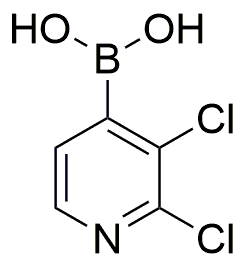2,3-Dichloropyridine-4-boronic acid is widely utilized in research focused on:
- Pharmaceutical Development: This compound serves as a key intermediate in the synthesis of various pharmaceuticals, particularly in the development of anti-cancer agents, enhancing the efficiency of drug discovery processes.
- Agricultural Chemistry: It is used in the formulation of herbicides and pesticides, contributing to improved crop protection strategies and sustainable agricultural practices.
- Material Science: The compound plays a role in the development of advanced materials, such as polymers and composites, which can exhibit enhanced properties like durability and resistance to environmental factors.
- Organic Synthesis: As a versatile building block, it is employed in various organic reactions, enabling chemists to create complex molecules with specific functionalities, thus streamlining synthetic pathways.
- Analytical Chemistry: It is utilized in the development of sensors and analytical methods for detecting specific analytes, providing reliable solutions for environmental monitoring and quality control in various industries.
General Information
Properties
Safety and Regulations
Applications
2,3-Dichloropyridine-4-boronic acid is widely utilized in research focused on:
- Pharmaceutical Development: This compound serves as a key intermediate in the synthesis of various pharmaceuticals, particularly in the development of anti-cancer agents, enhancing the efficiency of drug discovery processes.
- Agricultural Chemistry: It is used in the formulation of herbicides and pesticides, contributing to improved crop protection strategies and sustainable agricultural practices.
- Material Science: The compound plays a role in the development of advanced materials, such as polymers and composites, which can exhibit enhanced properties like durability and resistance to environmental factors.
- Organic Synthesis: As a versatile building block, it is employed in various organic reactions, enabling chemists to create complex molecules with specific functionalities, thus streamlining synthetic pathways.
- Analytical Chemistry: It is utilized in the development of sensors and analytical methods for detecting specific analytes, providing reliable solutions for environmental monitoring and quality control in various industries.
Documents
Safety Data Sheets (SDS)
The SDS provides comprehensive safety information on handling, storage, and disposal of the product.
Product Specification (PS)
The PS provides a comprehensive breakdown of the product’s properties, including chemical composition, physical state, purity, and storage requirements. It also details acceptable quality ranges and the product's intended applications.
Certificates of Analysis (COA)
Search for Certificates of Analysis (COA) by entering the products Lot Number. Lot and Batch Numbers can be found on a product’s label following the words ‘Lot’ or ‘Batch’.
Número de catálogo
Número de lote/lote
Certificates Of Origin (COO)
This COO confirms the country where the product was manufactured, and also details the materials and components used in it and whether it is derived from natural, synthetic, or other specific sources. This certificate may be required for customs, trade, and regulatory compliance.
Número de catálogo
Número de lote/lote
Safety Data Sheets (SDS)
The SDS provides comprehensive safety information on handling, storage, and disposal of the product.
DownloadProduct Specification (PS)
The PS provides a comprehensive breakdown of the product’s properties, including chemical composition, physical state, purity, and storage requirements. It also details acceptable quality ranges and the product's intended applications.
DownloadCertificates of Analysis (COA)
Search for Certificates of Analysis (COA) by entering the products Lot Number. Lot and Batch Numbers can be found on a product’s label following the words ‘Lot’ or ‘Batch’.
Número de catálogo
Número de lote/lote
Certificates Of Origin (COO)
This COO confirms the country where the product was manufactured, and also details the materials and components used in it and whether it is derived from natural, synthetic, or other specific sources. This certificate may be required for customs, trade, and regulatory compliance.


